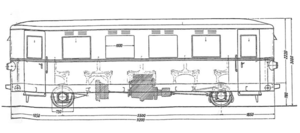KBO T1
| KBO T1 | |
|---|---|
|
Work drawing
|
|
| Numbering: |
KBO T1 BOE T101 ABE T1 AEE T10 |
| Number: | 1 |
| Manufacturer: | Waggonfabrik Gotha |
| Year of construction (s): | 1934 |
| Retirement: | after 1967 |
| Axis formula : | A1 |
| Genre : | CvT |
| Gauge : | 1435 mm ( standard gauge ) |
| Length over buffers: | since 1956: 11,700 mm |
| Length: | up to 1956: 9,200 mm |
| Height: | 3,000 mm |
| Width: | 3,000 mm |
| Total wheelbase: | 5,500 mm |
| Service mass: | originally 7,500 kg, after renovation 11,000 kg |
| Top speed: | 60 km / h |
| Installed capacity: | 48 kW (65 hp) |
| Wheel diameter: | 730 mm |
| Motor type: | Four-cylinder four-stroke diesel engine |
| Motor type: | Daimler-Benz OM 65 |
| Rated speed: | 2,000 rpm |
| Power transmission: | mechanical with Mylius gear |
| Seats: | 42 |
| Standing room: | 28 |
| Floor height: | 780 mm |
| Classes : | 3rd, from 1956: 2nd |
The two-axle internal combustion engine T1 of the Kleinbahn Bremervörde-Osterholz (KBO) was built in 1933 by the Gotha wagon factory . Originally it had no pulling and buffing device and operated as a single vehicle. In 1956 the railcar was rebuilt.
The railcar was also used on the Ankum-Bersenbrücker Railway and the Ahaus-Enscheder Railway , which was followed by a career with various museum railways in the Netherlands and Germany from 1967 . The railcar is located in Gotha in 2019 at the IG Hirzbergbahn is being historically refurbished.
History and commitment
Bremervörde-Osterholz small railway
In 1934, the company received the T1, a small, two-axle diesel railcar. Originally it had no pulling and buffing device and was only equipped with baffle plates for solo operation. In 1942 the company changed its name to Bremervörde-Osterholzer Eisenbahn (BOE). From 1949 the vehicle was redesignated as the T101 .
The railcar was converted from August 1955 to November 1956. The frame and chassis have been lengthened and an inclined windshield has been added. He also received a pulling and pushing device for taking sidecars.
Ankum-Bersenbrücker Railway
From April 1959 to October 1962 the railcar was in service with the Ankum-Bersenbrücker Railway. At the beginning it was still called T101 . From an unknown point in time, it was again referred to as T1 .
Ahaus-Enscheder Railway
From 1963 the railcar was used on the Ahaus-Enscheder Railway. It operated under the designation T10 until 1967 .
Use on museum railways
From 1967 to 1998 the railcar was in service with the Museum Buurtspoorweg in the Netherlands. This was followed by an assignment in the museum operations of the Delmenhorst-Harpstedter Railway until 2004 .
In the same year, the railcar was acquired by the railway friends of the Steinhuder Meer-Bahn and stored in the locomotive shed in Wunstorf . In 2016 it was taken over by IG Hirzbergbahn . The aim is the historical reconditioning of the vehicle.
technical features
The railcar was manufactured according to the principles of lightweight construction. The steering axles carried the car body on leaf springs . The driver's cab was not separated from the passenger compartment, luggage could be carried in the rear entrance area.
In 1955, the railcar was converted and enlarged for operation with a sidecar. The frame and chassis were lengthened and two additional windows were installed on the side walls for an enlarged vestibule. The entrance doors were converted from revolving to sliding doors. The passenger compartment remained unchanged, as after the renovation there were only fans over four windows. The number of seats has not changed.
Furthermore, the front was redesigned, the front windows were bevelled. The interior is in the state of the 1950s in the west. During the renovation, the railcar received partition walls between the passenger compartment and the entry area as well as more comfortable seats.
The engine and gearbox were mounted on a support frame and suspended from the base. The engine protruded into the passenger compartment. It was covered by a bench in the middle. The four-cylinder four-stroke diesel engine of the Daimler-Benz OM 65 type was used as the engine; the power transmission system is via a Mylius gearbox with four gears. During test drives, speeds of up to 70 km / h were achieved.
literature
- Author collective: A new light railcar for small railways. In: Verkehrstechnik. Issue 10, May 20, 1933.
- Gerd Wolff: German small and private railways . tape 10 : Lower Saxony part 2 . EK-Verlag, Freiburg 2007, ISBN 978-3-88255-669-8 .
Web links
- Record of the BOE with mention of T1
- Internet site of the IG Hirzbergbahn with mention of the T101
Individual evidence
- ↑ Photo of the BOE VT101
- ↑ Gerd Wolff: German small and private railways . tape 10 : Lower Saxony part 2 . EK-Verlag, Freiburg 2007, ISBN 978-3-88255-669-8 , p. 119 .
- ↑ a b c d data sheet of the BOE with mention of the T101
- ↑ a b Photo of the BOE VT101 at the IG Hirzbergbahn
- ↑ a b c Internet site of the IG Hirzbergbahn
- ↑ Newspaper article about the processing of the T101 of the IG Hirzbergbahn
- ↑ a b Author collective: A new light railcar for small railways. In: Verkehrstechnik. Issue 10, May 20, 1933.
- ↑ Photo of the interior of the T101 at the IG Hirzbergbahn
